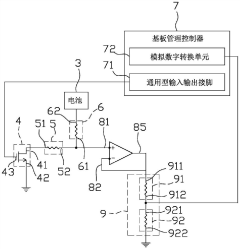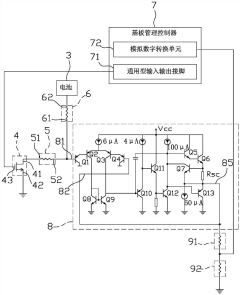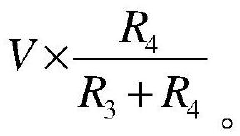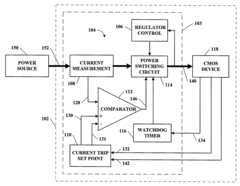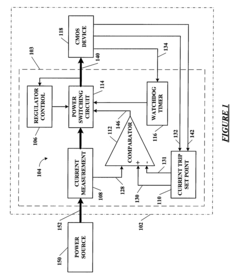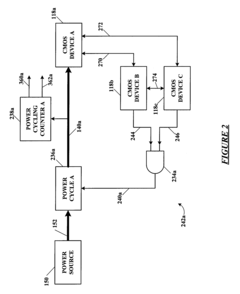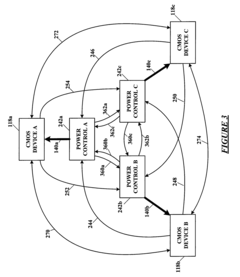How to Monitor CMOS Battery Levels Remotely?
JUL 22, 20259 MIN READ
Generate Your Research Report Instantly with AI Agent
Patsnap Eureka helps you evaluate technical feasibility & market potential.
CMOS Battery Monitoring: Background and Objectives
CMOS (Complementary Metal-Oxide-Semiconductor) batteries play a crucial role in maintaining system settings and real-time clock information in computers and other electronic devices. These small, coin-shaped batteries typically have a lifespan of 3-5 years, but their failure can lead to significant system issues, including loss of BIOS settings and incorrect system time.
The evolution of CMOS battery technology has been closely tied to the development of computer systems. Initially introduced in the 1980s with the advent of IBM PC/AT computers, CMOS batteries have become an integral component in modern computing devices. Over time, the focus has shifted from merely powering BIOS memory to supporting a wider range of low-power functions in various electronic devices.
As technology has advanced, the need for remote monitoring of CMOS battery levels has become increasingly important, especially in large-scale IT environments and data centers. Traditional methods of checking CMOS battery status often require physical access to the device, which can be time-consuming and impractical in many scenarios.
The primary objective of remote CMOS battery monitoring is to proactively identify and address potential battery failures before they cause system disruptions. This approach aims to enhance system reliability, reduce downtime, and streamline maintenance processes in both corporate and personal computing environments.
Remote monitoring of CMOS battery levels presents several technical challenges. These include developing accurate measurement techniques that can be implemented without direct physical access, creating efficient data transmission protocols for battery status information, and designing user-friendly interfaces for system administrators to monitor and manage multiple devices simultaneously.
The trend towards remote management and monitoring in IT infrastructure has further emphasized the importance of this technology. As organizations increasingly rely on distributed computing resources and cloud-based systems, the ability to remotely monitor and manage all aspects of system health, including CMOS battery levels, has become a critical requirement for efficient IT operations.
Looking ahead, the future of CMOS battery monitoring is likely to involve more sophisticated predictive analytics, integration with broader system health monitoring tools, and potentially the development of self-monitoring and self-reporting battery technologies. These advancements will contribute to more robust and autonomous computing systems, further reducing the need for manual intervention and improving overall system reliability.
The evolution of CMOS battery technology has been closely tied to the development of computer systems. Initially introduced in the 1980s with the advent of IBM PC/AT computers, CMOS batteries have become an integral component in modern computing devices. Over time, the focus has shifted from merely powering BIOS memory to supporting a wider range of low-power functions in various electronic devices.
As technology has advanced, the need for remote monitoring of CMOS battery levels has become increasingly important, especially in large-scale IT environments and data centers. Traditional methods of checking CMOS battery status often require physical access to the device, which can be time-consuming and impractical in many scenarios.
The primary objective of remote CMOS battery monitoring is to proactively identify and address potential battery failures before they cause system disruptions. This approach aims to enhance system reliability, reduce downtime, and streamline maintenance processes in both corporate and personal computing environments.
Remote monitoring of CMOS battery levels presents several technical challenges. These include developing accurate measurement techniques that can be implemented without direct physical access, creating efficient data transmission protocols for battery status information, and designing user-friendly interfaces for system administrators to monitor and manage multiple devices simultaneously.
The trend towards remote management and monitoring in IT infrastructure has further emphasized the importance of this technology. As organizations increasingly rely on distributed computing resources and cloud-based systems, the ability to remotely monitor and manage all aspects of system health, including CMOS battery levels, has become a critical requirement for efficient IT operations.
Looking ahead, the future of CMOS battery monitoring is likely to involve more sophisticated predictive analytics, integration with broader system health monitoring tools, and potentially the development of self-monitoring and self-reporting battery technologies. These advancements will contribute to more robust and autonomous computing systems, further reducing the need for manual intervention and improving overall system reliability.
Market Demand for Remote CMOS Battery Monitoring
The market demand for remote CMOS battery monitoring has been steadily increasing in recent years, driven by the growing complexity of IT infrastructure and the need for proactive maintenance in data centers and enterprise environments. As organizations rely more heavily on uninterrupted computer operations, the ability to remotely monitor CMOS battery levels has become a critical component of system management strategies.
One of the primary factors fueling this demand is the potential for significant cost savings. By implementing remote monitoring solutions, companies can reduce the need for on-site inspections and minimize system downtime caused by unexpected CMOS battery failures. This is particularly valuable for large-scale operations with numerous servers and workstations spread across multiple locations.
The healthcare sector has emerged as a key market for remote CMOS battery monitoring solutions. Hospitals and medical facilities require constant uptime for their critical systems, and any unexpected shutdowns due to CMOS battery failure could have severe consequences. As a result, there is a growing demand for reliable monitoring tools that can provide early warnings and facilitate timely replacements.
Financial institutions and stock exchanges represent another significant market segment. These organizations rely on high-frequency trading systems and real-time data processing, where even brief interruptions can result in substantial financial losses. Remote CMOS battery monitoring offers a layer of protection against unexpected system failures, making it an attractive investment for risk-averse financial entities.
The rise of edge computing and distributed IT infrastructure has further amplified the need for remote monitoring capabilities. As computing resources are increasingly deployed in remote locations and harsh environments, the ability to monitor CMOS battery health from a centralized location becomes crucial for maintaining system integrity and reducing maintenance costs.
Cloud service providers and data center operators are also driving demand for advanced CMOS battery monitoring solutions. With the exponential growth of cloud computing, these companies manage vast numbers of servers and need efficient ways to monitor and maintain their hardware components, including CMOS batteries.
The market for remote CMOS battery monitoring is expected to see continued growth in the coming years, with a particular emphasis on integration with broader IT infrastructure management platforms. This trend is likely to be accelerated by the increasing adoption of artificial intelligence and machine learning technologies, which can enhance predictive maintenance capabilities and further optimize system performance.
One of the primary factors fueling this demand is the potential for significant cost savings. By implementing remote monitoring solutions, companies can reduce the need for on-site inspections and minimize system downtime caused by unexpected CMOS battery failures. This is particularly valuable for large-scale operations with numerous servers and workstations spread across multiple locations.
The healthcare sector has emerged as a key market for remote CMOS battery monitoring solutions. Hospitals and medical facilities require constant uptime for their critical systems, and any unexpected shutdowns due to CMOS battery failure could have severe consequences. As a result, there is a growing demand for reliable monitoring tools that can provide early warnings and facilitate timely replacements.
Financial institutions and stock exchanges represent another significant market segment. These organizations rely on high-frequency trading systems and real-time data processing, where even brief interruptions can result in substantial financial losses. Remote CMOS battery monitoring offers a layer of protection against unexpected system failures, making it an attractive investment for risk-averse financial entities.
The rise of edge computing and distributed IT infrastructure has further amplified the need for remote monitoring capabilities. As computing resources are increasingly deployed in remote locations and harsh environments, the ability to monitor CMOS battery health from a centralized location becomes crucial for maintaining system integrity and reducing maintenance costs.
Cloud service providers and data center operators are also driving demand for advanced CMOS battery monitoring solutions. With the exponential growth of cloud computing, these companies manage vast numbers of servers and need efficient ways to monitor and maintain their hardware components, including CMOS batteries.
The market for remote CMOS battery monitoring is expected to see continued growth in the coming years, with a particular emphasis on integration with broader IT infrastructure management platforms. This trend is likely to be accelerated by the increasing adoption of artificial intelligence and machine learning technologies, which can enhance predictive maintenance capabilities and further optimize system performance.
Current Challenges in Remote CMOS Battery Monitoring
Remote monitoring of CMOS battery levels presents several significant challenges that hinder widespread implementation and reliability. One of the primary obstacles is the lack of standardized protocols for remote battery level detection across different computer systems and motherboard designs. This diversity in hardware configurations makes it difficult to develop a universal solution that can accurately monitor CMOS batteries across various platforms.
Another major challenge is the limited power capacity of CMOS batteries themselves. These batteries are designed for low power consumption and long-term stability rather than frequent status reporting. Implementing remote monitoring features may inadvertently increase the power drain on these batteries, potentially shortening their lifespan and defeating the purpose of monitoring.
The physical location and integration of CMOS batteries within computer systems also pose difficulties for remote monitoring. Often deeply embedded within the motherboard, these batteries lack direct external connections, making it challenging to interface with them without significant hardware modifications. This integration complicates the process of retrofitting existing systems with remote monitoring capabilities.
Security concerns present another layer of complexity. As CMOS batteries store critical system information, including BIOS settings, any remote access mechanism could potentially be exploited by malicious actors. Ensuring the security of remote monitoring systems while maintaining their functionality is a delicate balance that requires careful consideration and robust security measures.
Accuracy and reliability of remote battery level measurements are also significant challenges. CMOS batteries typically have a very long lifespan, making it difficult to detect gradual degradation over time. Developing sensors and algorithms that can accurately predict battery failure well in advance, without generating false alarms, remains a technical hurdle.
Furthermore, the cost-effectiveness of implementing remote CMOS battery monitoring systems is a concern for many organizations. The potential benefits must be weighed against the expenses of hardware modifications, software development, and ongoing maintenance. For many systems, especially those not in critical environments, the cost of implementation may outweigh the perceived benefits.
Lastly, there is a challenge in integrating CMOS battery monitoring into existing IT infrastructure and management systems. Developing interfaces that can seamlessly incorporate battery status information into broader system health monitoring tools, while providing meaningful alerts and actionable insights, requires significant development effort and standardization.
Another major challenge is the limited power capacity of CMOS batteries themselves. These batteries are designed for low power consumption and long-term stability rather than frequent status reporting. Implementing remote monitoring features may inadvertently increase the power drain on these batteries, potentially shortening their lifespan and defeating the purpose of monitoring.
The physical location and integration of CMOS batteries within computer systems also pose difficulties for remote monitoring. Often deeply embedded within the motherboard, these batteries lack direct external connections, making it challenging to interface with them without significant hardware modifications. This integration complicates the process of retrofitting existing systems with remote monitoring capabilities.
Security concerns present another layer of complexity. As CMOS batteries store critical system information, including BIOS settings, any remote access mechanism could potentially be exploited by malicious actors. Ensuring the security of remote monitoring systems while maintaining their functionality is a delicate balance that requires careful consideration and robust security measures.
Accuracy and reliability of remote battery level measurements are also significant challenges. CMOS batteries typically have a very long lifespan, making it difficult to detect gradual degradation over time. Developing sensors and algorithms that can accurately predict battery failure well in advance, without generating false alarms, remains a technical hurdle.
Furthermore, the cost-effectiveness of implementing remote CMOS battery monitoring systems is a concern for many organizations. The potential benefits must be weighed against the expenses of hardware modifications, software development, and ongoing maintenance. For many systems, especially those not in critical environments, the cost of implementation may outweigh the perceived benefits.
Lastly, there is a challenge in integrating CMOS battery monitoring into existing IT infrastructure and management systems. Developing interfaces that can seamlessly incorporate battery status information into broader system health monitoring tools, while providing meaningful alerts and actionable insights, requires significant development effort and standardization.
Existing Remote Monitoring Solutions for CMOS Batteries
01 CMOS battery monitoring and management
Systems and methods for monitoring CMOS battery levels and managing power consumption. This includes techniques for detecting low battery conditions, implementing power-saving modes, and ensuring data retention during battery replacement.- CMOS battery monitoring and management: Systems and methods for monitoring and managing CMOS battery levels in electronic devices. This includes techniques for detecting low battery conditions, providing warnings, and implementing power-saving measures to extend battery life.
- Battery level detection circuits: Specialized circuits designed to accurately measure and report CMOS battery voltage levels. These circuits may include comparators, voltage dividers, and reference voltage sources to determine when battery levels fall below critical thresholds.
- Power management in CMOS devices: Techniques for optimizing power consumption in CMOS devices to prolong battery life. This may include selective powering of circuits, clock gating, and dynamic voltage scaling based on battery levels and system requirements.
- CMOS battery backup systems: Implementations of backup power systems for CMOS devices to maintain critical data and settings during main power loss or battery replacement. This includes switching mechanisms between primary and backup power sources based on detected voltage levels.
- Integration of battery management in imaging devices: Specific applications of CMOS battery level management in cameras and other imaging devices. This includes power-saving modes, battery level indicators, and safe shutdown procedures to protect image data when battery levels are critically low.
02 Battery level detection circuits
Specialized circuits designed to accurately measure and report CMOS battery voltage levels. These circuits may include comparators, voltage dividers, and reference voltage sources to determine when battery levels fall below critical thresholds.Expand Specific Solutions03 Low-power CMOS designs for battery conservation
Circuit design techniques and architectures that minimize power consumption in CMOS devices, thereby extending the life of the backup battery. This includes power gating, clock gating, and selective powering of critical components.Expand Specific Solutions04 Battery backup switching mechanisms
Mechanisms for seamlessly switching between main power and battery backup power in CMOS systems. These designs ensure uninterrupted operation of critical functions and data retention when main power is lost or during battery replacement.Expand Specific Solutions05 Integration of battery management with system functions
Methods for integrating CMOS battery level monitoring and management with other system functions, such as power-on self-test (POST), BIOS operations, and system diagnostics. This integration allows for more comprehensive power management and system reliability.Expand Specific Solutions
Key Players in CMOS Battery Monitoring Industry
The market for remote CMOS battery monitoring is in its early growth stage, with increasing demand driven by the rise of IoT and remote device management. The global market size is estimated to be in the hundreds of millions of dollars, with significant growth potential. Technologically, solutions are still evolving, ranging from basic voltage monitoring to more advanced predictive analytics. Key players like Analog Devices and ACCURE Battery Intelligence are developing sophisticated battery management systems, while companies such as Wasion Group and Tencent are integrating these technologies into broader IoT and smart energy solutions. The involvement of major tech firms and specialized battery intelligence companies indicates a maturing but still-developing technological landscape.
Analog Devices, Inc.
Technical Solution: Analog Devices has engineered a sophisticated remote CMOS battery monitoring solution leveraging their expertise in analog and mixed-signal integrated circuits. Their system employs high-precision analog-to-digital converters (ADCs) to measure battery voltage with exceptional accuracy[4]. The solution incorporates low-power microcontrollers for local processing and wireless communication modules for remote data transmission. ADI's proprietary power management ICs ensure minimal power consumption during monitoring, extending the overall battery life[5]. The system can detect subtle voltage fluctuations, providing early warnings for potential battery failures. It also features temperature compensation to account for environmental factors affecting battery performance[6].
Strengths: High-precision measurements, low power consumption, temperature compensation. Weaknesses: May be more expensive than simpler solutions, potentially complex implementation for non-technical users.
Wasion Group Ltd.
Technical Solution: Wasion Group has created an innovative remote CMOS battery monitoring system as part of their smart energy management solutions. Their approach integrates battery monitoring into broader power management systems, providing a holistic view of energy usage and storage. The solution uses advanced power line communication (PLC) technology to transmit battery data through existing electrical wiring, eliminating the need for additional network infrastructure[9]. Wasion's system employs smart algorithms to analyze historical battery performance, enabling accurate predictions of remaining battery life. It also features adaptive sampling rates, adjusting monitoring frequency based on battery condition to optimize power consumption and data transmission[10].
Strengths: Integration with broader energy management systems, use of existing power lines for communication, adaptive monitoring. Weaknesses: Reliance on power line quality for data transmission, may require specialized expertise for installation.
Innovative Approaches to Remote CMOS Battery Monitoring
Mainboard battery detection device
PatentActiveCN112286739A
Innovation
- A detection device including a transistor, a first resistor, a second resistor, a substrate management controller and a voltage follower is used to determine the battery by comparing the voltage difference output by the voltage follower when the transistor is on and off. exists.
Automatic detection of a CMOS device in latch-up and cycling of power thereto
PatentActiveUS7907378B2
Innovation
- A monitoring and protection circuit integrated with the voltage regulator that measures current and automatically generates a fault alert or cycles power to the CMOS device when abnormal current levels are detected, adjusting trip points based on device state information to prevent damage and ensure recovery from latch-up conditions.
Security Implications of Remote CMOS Battery Monitoring
Remote monitoring of CMOS battery levels introduces several security implications that organizations must carefully consider. The primary concern revolves around the potential for unauthorized access to critical system information and settings. CMOS batteries maintain essential BIOS configurations, including boot sequences, hardware settings, and system time. If an attacker gains remote access to monitor these battery levels, they might also exploit vulnerabilities to manipulate BIOS settings, potentially compromising the entire system.
Furthermore, remote monitoring capabilities could be leveraged as a covert channel for data exfiltration. Malicious actors might use the battery monitoring system as a conduit to transmit sensitive information out of the organization, bypassing traditional security controls. This risk is particularly significant in air-gapped systems where standard network-based exfiltration methods are not feasible.
Another security implication is the potential for denial-of-service attacks. An attacker could deliberately drain the CMOS battery remotely, causing system instability or failure. This could lead to data loss, system downtime, and disruption of critical business operations. In scenarios where remote monitoring is implemented across multiple systems, a coordinated attack could result in widespread organizational impact.
Privacy concerns also arise from remote CMOS battery monitoring. The data collected could potentially be used to infer usage patterns, system uptime, and other behavioral information about users or organizations. This information, while seemingly innocuous, could be valuable for adversaries planning more sophisticated attacks or conducting corporate espionage.
The implementation of remote monitoring systems introduces new attack surfaces and potential vulnerabilities. Each component of the monitoring infrastructure, including sensors, communication protocols, and management interfaces, becomes a potential target for exploitation. Ensuring the security of these components is crucial to prevent them from becoming entry points for broader system compromise.
Lastly, regulatory compliance issues may emerge, particularly in industries handling sensitive data. Remote monitoring of system components like CMOS batteries might fall under the purview of data protection regulations, requiring organizations to implement stringent security measures and obtain necessary approvals before deployment.
Furthermore, remote monitoring capabilities could be leveraged as a covert channel for data exfiltration. Malicious actors might use the battery monitoring system as a conduit to transmit sensitive information out of the organization, bypassing traditional security controls. This risk is particularly significant in air-gapped systems where standard network-based exfiltration methods are not feasible.
Another security implication is the potential for denial-of-service attacks. An attacker could deliberately drain the CMOS battery remotely, causing system instability or failure. This could lead to data loss, system downtime, and disruption of critical business operations. In scenarios where remote monitoring is implemented across multiple systems, a coordinated attack could result in widespread organizational impact.
Privacy concerns also arise from remote CMOS battery monitoring. The data collected could potentially be used to infer usage patterns, system uptime, and other behavioral information about users or organizations. This information, while seemingly innocuous, could be valuable for adversaries planning more sophisticated attacks or conducting corporate espionage.
The implementation of remote monitoring systems introduces new attack surfaces and potential vulnerabilities. Each component of the monitoring infrastructure, including sensors, communication protocols, and management interfaces, becomes a potential target for exploitation. Ensuring the security of these components is crucial to prevent them from becoming entry points for broader system compromise.
Lastly, regulatory compliance issues may emerge, particularly in industries handling sensitive data. Remote monitoring of system components like CMOS batteries might fall under the purview of data protection regulations, requiring organizations to implement stringent security measures and obtain necessary approvals before deployment.
Energy Efficiency in Remote Monitoring Systems
Energy efficiency is a critical consideration in remote monitoring systems, particularly when it comes to monitoring CMOS battery levels. These systems often operate in environments where power sources are limited or difficult to access, making energy conservation paramount. The design of energy-efficient remote monitoring solutions for CMOS batteries requires a multifaceted approach that addresses both hardware and software components.
At the hardware level, low-power microcontrollers and sensors form the foundation of energy-efficient remote monitoring systems. These components are specifically designed to operate with minimal power consumption, often featuring sleep modes and wake-on-event capabilities. Advanced power management integrated circuits (PMICs) play a crucial role in optimizing power distribution and minimizing energy waste across the system.
Wireless communication technologies are integral to remote monitoring, but they can be significant power drains if not implemented judiciously. Low-power wide-area network (LPWAN) protocols, such as LoRaWAN or NB-IoT, offer long-range communication capabilities while consuming minimal energy. These protocols are particularly well-suited for transmitting small packets of data, such as CMOS battery level readings, over extended periods.
On the software side, intelligent algorithms and adaptive sampling techniques contribute significantly to energy efficiency. Dynamic sampling rates that adjust based on battery level trends or environmental factors can reduce unnecessary data transmission and processing. Predictive analytics can be employed to anticipate battery depletion, allowing for proactive maintenance and reducing the frequency of physical inspections.
Energy harvesting technologies present an innovative approach to extending the operational lifespan of remote monitoring systems. Solar panels, thermoelectric generators, or even vibration-based energy harvesters can be integrated to supplement or recharge the primary power source. This approach is particularly valuable in outdoor or industrial settings where ambient energy sources are readily available.
Data compression and efficient encoding schemes further contribute to energy conservation by reducing the volume of information that needs to be transmitted. By minimizing the data payload, these techniques not only save energy during transmission but also reduce the processing requirements at both the sensor and receiver ends.
Implementing robust error correction and retransmission protocols ensures data integrity while minimizing energy waste due to failed transmissions. These protocols must be carefully balanced to provide reliability without introducing excessive overhead that could negate energy savings.
In conclusion, achieving energy efficiency in remote CMOS battery monitoring systems requires a holistic approach that leverages advancements in hardware, software, and communication technologies. By carefully optimizing each component and considering the system as a whole, it is possible to create robust, long-lasting monitoring solutions that operate reliably in even the most challenging environments.
At the hardware level, low-power microcontrollers and sensors form the foundation of energy-efficient remote monitoring systems. These components are specifically designed to operate with minimal power consumption, often featuring sleep modes and wake-on-event capabilities. Advanced power management integrated circuits (PMICs) play a crucial role in optimizing power distribution and minimizing energy waste across the system.
Wireless communication technologies are integral to remote monitoring, but they can be significant power drains if not implemented judiciously. Low-power wide-area network (LPWAN) protocols, such as LoRaWAN or NB-IoT, offer long-range communication capabilities while consuming minimal energy. These protocols are particularly well-suited for transmitting small packets of data, such as CMOS battery level readings, over extended periods.
On the software side, intelligent algorithms and adaptive sampling techniques contribute significantly to energy efficiency. Dynamic sampling rates that adjust based on battery level trends or environmental factors can reduce unnecessary data transmission and processing. Predictive analytics can be employed to anticipate battery depletion, allowing for proactive maintenance and reducing the frequency of physical inspections.
Energy harvesting technologies present an innovative approach to extending the operational lifespan of remote monitoring systems. Solar panels, thermoelectric generators, or even vibration-based energy harvesters can be integrated to supplement or recharge the primary power source. This approach is particularly valuable in outdoor or industrial settings where ambient energy sources are readily available.
Data compression and efficient encoding schemes further contribute to energy conservation by reducing the volume of information that needs to be transmitted. By minimizing the data payload, these techniques not only save energy during transmission but also reduce the processing requirements at both the sensor and receiver ends.
Implementing robust error correction and retransmission protocols ensures data integrity while minimizing energy waste due to failed transmissions. These protocols must be carefully balanced to provide reliability without introducing excessive overhead that could negate energy savings.
In conclusion, achieving energy efficiency in remote CMOS battery monitoring systems requires a holistic approach that leverages advancements in hardware, software, and communication technologies. By carefully optimizing each component and considering the system as a whole, it is possible to create robust, long-lasting monitoring solutions that operate reliably in even the most challenging environments.
Unlock deeper insights with Patsnap Eureka Quick Research — get a full tech report to explore trends and direct your research. Try now!
Generate Your Research Report Instantly with AI Agent
Supercharge your innovation with Patsnap Eureka AI Agent Platform!

